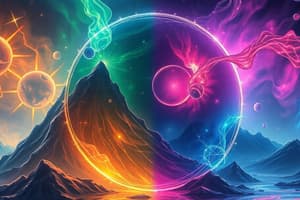Podcast
Questions and Answers
What describes a solid that lacks an ordered internal structure?
What describes a solid that lacks an ordered internal structure?
- Crystalline
- Ordered
- Amorphous (correct)
- Structured
What is the smallest group of particles within a crystal that retains the shape of the crystal?
What is the smallest group of particles within a crystal that retains the shape of the crystal?
Unit cell
What is a solid in which the particles are arranged in an orderly, repeating, three-dimensional pattern?
What is a solid in which the particles are arranged in an orderly, repeating, three-dimensional pattern?
Crystal
What is the temperature at which a liquid boils at a pressure of 101.3 kPa?
What is the temperature at which a liquid boils at a pressure of 101.3 kPa?
What is an empty space with no particles of matter called?
What is an empty space with no particles of matter called?
What is the temperature at which a solid changes into a liquid?
What is the temperature at which a solid changes into a liquid?
What device is used to measure atmospheric pressure?
What device is used to measure atmospheric pressure?
What is the pressure resulting from the collision of particles in air with objects?
What is the pressure resulting from the collision of particles in air with objects?
What is the temperature at which the vapor pressure of a liquid is equal to the external pressure?
What is the temperature at which the vapor pressure of a liquid is equal to the external pressure?
What is a measure of the force exerted by a gas above a liquid?
What is a measure of the force exerted by a gas above a liquid?
What is one of two or more different molecular forms of the same element in the same physical state?
What is one of two or more different molecular forms of the same element in the same physical state?
What is the conversion of a liquid to a gas or vapor at a temperature below the boiling point?
What is the conversion of a liquid to a gas or vapor at a temperature below the boiling point?
What states that the tiny particles in all forms of matter are in constant motion?
What states that the tiny particles in all forms of matter are in constant motion?
What is the change of a solid to a vapor without passing through the liquid state called?
What is the change of a solid to a vapor without passing through the liquid state called?
In which state is the average kinetic energy of water molecules greatest?
In which state is the average kinetic energy of water molecules greatest?
According to the kinetic theory of gases, which of the following statements is true?
According to the kinetic theory of gases, which of the following statements is true?
What is the temperature at which the motion of particles theoretically ceases?
What is the temperature at which the motion of particles theoretically ceases?
The average kinetic energy of particles of a substance is:
The average kinetic energy of particles of a substance is:
Which of these statements is not true, according to the kinetic theory?
Which of these statements is not true, according to the kinetic theory?
Standard conditions when working with gases are defined as:
Standard conditions when working with gases are defined as:
The pressure of a gas in a container is 76 mm Hg. This is equivalent to:
The pressure of a gas in a container is 76 mm Hg. This is equivalent to:
A phase diagram gives information on:
A phase diagram gives information on:
An increase in the temperature of a contained liquid:
An increase in the temperature of a contained liquid:
Water could be made to boil at 105 degrees Celsius by:
Water could be made to boil at 105 degrees Celsius by:
What is the direct change of a substance from a solid to a vapor called?
What is the direct change of a substance from a solid to a vapor called?
Most solids are:
Most solids are:
What is the escape of molecules from the surface of an uncontained liquid called?
What is the escape of molecules from the surface of an uncontained liquid called?
The rates of evaporation and condensation are equal at equilibrium.
The rates of evaporation and condensation are equal at equilibrium.
The kinetic energy of all the particles in a given sample of matter is the same.
The kinetic energy of all the particles in a given sample of matter is the same.
The average kinetic energy of all the molecules in liquid water at 80 degrees Celsius is the same as the average kinetic energy of the molecules in oxygen gas at 80 degrees Celsius.
The average kinetic energy of all the molecules in liquid water at 80 degrees Celsius is the same as the average kinetic energy of the molecules in oxygen gas at 80 degrees Celsius.
Heating a liquid will increase the temperature of the liquid.
Heating a liquid will increase the temperature of the liquid.
The melting point and freezing point of a substance are the same.
The melting point and freezing point of a substance are the same.
Flashcards are hidden until you start studying
Study Notes
States of Matter Concepts
- Amorphous: Solids lacking a defined internal structure, unlike crystalline solids.
- Unit Cell: The smallest repeating unit in a crystal structure that maintains the overall shape of the crystal.
- Crystal: A three-dimensional solid whose particles are arranged in an orderly repeating pattern.
Phase Changes and Characteristics
- Normal Boiling Point: The temperature where a liquid boils under a pressure of 101.3 kPa.
- Melting Point: The temperature at which a solid transforms into a liquid.
- Boiling Point: The condition when vapor pressure matches external pressure.
- Vacuum: A space void of matter or particles.
Gas and Pressure Concepts
- Vapor Pressure: The pressure exerted by a gas in equilibrium with its liquid phase.
- Barometer: An instrument for measuring atmospheric pressure.
- Atmospheric Pressure: The pressure from air particles colliding with surfaces.
Kinetic Theory of Matter
- Kinetic Theory: All matter consists of tiny particles in continuous motion, impacting temperature and pressure.
- Average Kinetic Energy: Directly correlates with a substance's temperature, higher in gas than liquid state.
- 0 degrees Kelvin: Theoretical point at which particle motion stops.
Allotropes and Sublimation
- Allotropes: Different structural forms of the same element in the same state.
- Sublimation: Transition from solid to gas without becoming a liquid.
- Evaporation: The process of a liquid turning into vapor below its boiling point.
Equilibrium and Pressure Relationships
- Equilibrium: Equal rates of evaporation and condensation in a closed system.
- Liquid Behavior: Increasing temperature in a contained liquid raises vapor pressure.
- Phase Diagram: A graphical representation showing the states of a substance under varying conditions.
Specific Gaseous Conditions
- Standard Conditions: Defined at 0 degrees Celsius and 101.3 kPa.
- Pressure Conversion: 76 mm Hg is equivalent to approximately 0.1 atm.
- Boiling Water at High Temperatures: Can occur by increasing air pressure above it.
Miscellaneous Properties
- Most Solids: Characterized by high density and low compressibility.
- Heating Liquids: Generally raises their temperature, but not always.
- Melting and Freezing Points: Identical for a given substance, establishing thermal equilibrium in solid-liquid transitions.
Studying That Suits You
Use AI to generate personalized quizzes and flashcards to suit your learning preferences.




